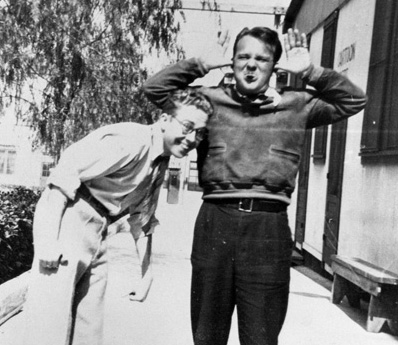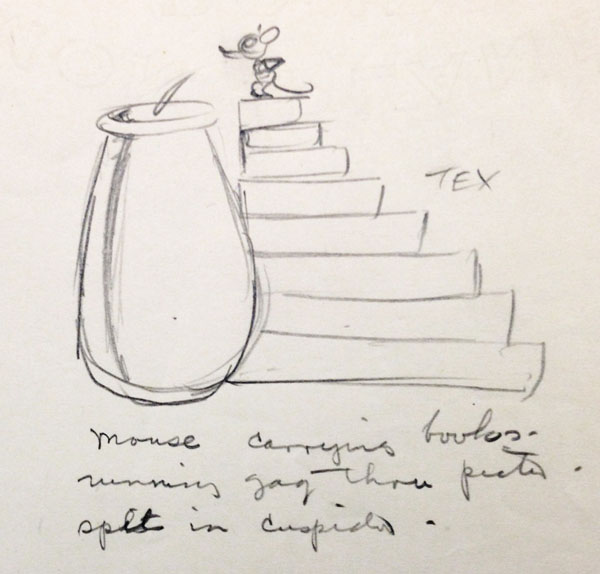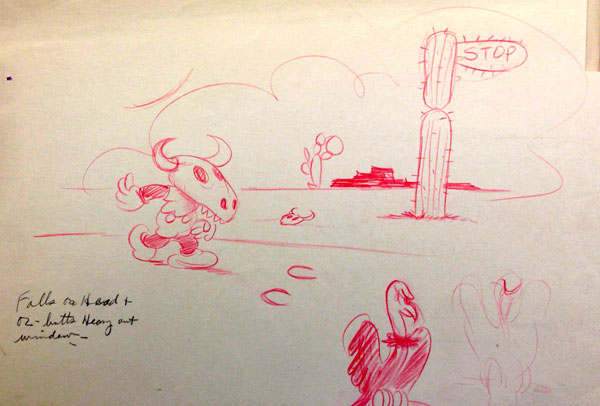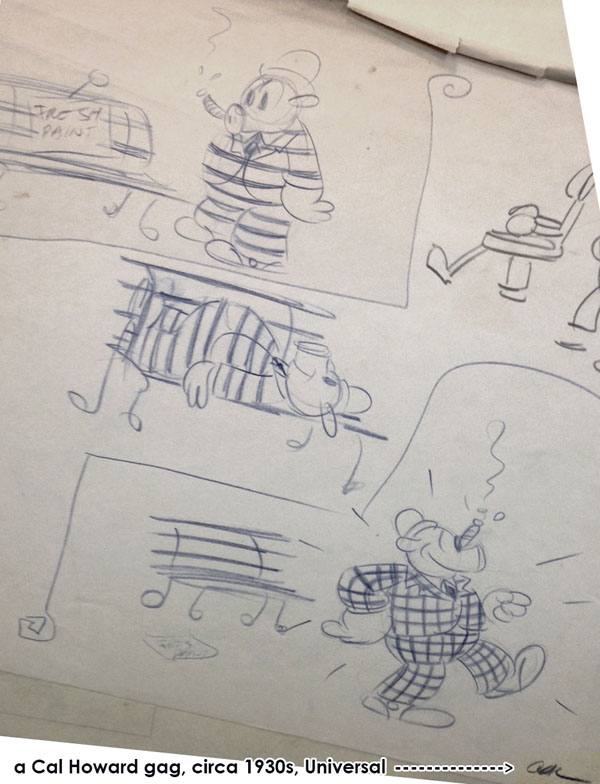
This photograph of Cal Howard (leaning in) and Tex Avery standing in front of the Universal Cartoon Department is courtesy of Michael Barrier.
Within archival sketches that survive from the early years when Walter Lantz was at the helm of the Universal Cartoon Department, there is the intriguing prospect of wondering who exactly drew any particular gag. Fortunately, because of Lantz’s policy of offering a small bonus for material that was subsequently used in a film, there was an incentive for animators to put their names on their work for the obvious reason of collecting on their efforts and ensuring no dispute.
In one gag submitted by Cal Howard, so confirmed because his name’s on it, he even wrote “Yes it’s original” to boost its stock upon review. However, most surviving sketches are unsigned, so this gives the ones with signatures quite a bit of weight in regard to historical verification. Eighty years after these enjoyable gags were first scribbled, I now care less if it’s original than if I can discern who drew it.
And within the company of early 1930s Universal animators, the big fish is undoubtedly Tex Avery, the masterful innovator of midcentury cartoon humor. Anything that he drew as a young man in his twenties has the patina of being a stepping stone to his eventual greatness, a formative look at what was gurgling under the hood. It was while working on the Lantz-produced Oswalds that he developed his sensibility for the absurd and outrageous.
So, here is a Rosetta Stone of sorts: a gag sketch that shows a little mouse spitting in a pot. It has a rough cursive caption describing it as a “mouse carrying books—running gag thru picture—spits in cuspidor.” It may not seem the stuff of comedy legend, but the deadpan approach of a repeated interruption is surely Avery-esque. Fortunately I don’t think this requires conjecture to make that leap because this is a gag attributed to “TEX” on the paper itself, thereby making a very strong case to count this as his work.

I mention this as a Rosetta Stone because if we accept this as the work of Avery, then we can use its clues to extend our claims on attributing other unsigned gags to him. We can use the telltale visual indicators from either the drawing or his penmanship. Below, for instance, is one gag that I think passes the Avery ‘cuspidor’ test. The cursive has some distinct similarities to the other caption. Also, compare the print writing of “TEX” and “STOP.” It seems a match.
So, here is the little gift of the diligent cartoon researcher: I think I have unearthed a heretofore unknown Tex Avery drawing, plucked from over eighty years of obscurity. It is Oswald the Lucky Rabbit walking aimlessly through a desolate Southwestern landscape à la Krazy Kat. With a cattle skull popped over his head, Oswald cannot see the cactus’ traffic warning. The caption reads, “Falls on Head +or butts Heavy out window.”

One probable reason this is unsigned is that it does not appear to be a formal gag submission. This seems more like a case of scribble-thinking or an idea loosely taking shape at the tip of Avery’s pencil. More than likely this is Tex creatively searching for the comic structure of a cartoon short or some extended sequence within it. We see a vulture on this page too, and we’re also left to wonder who gets butted out of a window?
Years ago when I interviewed Ed Benedict, who was a colleague of Avery on those Oswald cartoons, he said, “A gag was Tex’s forte of thought.” He also told me that Tex was constantly scribbling his newly inspired ideas on sheets of paper that he would then indiscriminately stockpile by pushing these sheets to the back of his desk. There were lots them, a crumpled stack of his comic daydreams.
And the Universal animator who most shared Tex’s love of provocation was Cal Howard, who—a bit shorter in stature and more slight-of-frame—might have seemed like an Avery sidekick. These two men were a prankster duo who prowled for victims, offering daily hijinks in the midst of the work at Universal. They were both gag-initiators. They punked their colleagues and they were in equal measure considered among the best gag contributors to the Oswald cartoons.
If ever there were a show to be made about this moment in industry, something in line with AMC’s Mad Men, then perhaps Gag Men might be an apt title for the full commitment that we know guys like Tex and Cal gave to this “forte of thought,” the unchecked fervor to always be making a joke, no matter the consequence (yes, Tex actually lost his eye for his art).
All these years later, it makes for some terrific moments of discovery. For example, I’m a fan of this little comic gem, below, from Cal Howard. A guy (really, a cigar-chomping pig) with a striped suit lies down on a freshly painted bench. Then, voilà, a checker-pattern suit! Perhaps the man who grew to become legendary had in Cal Howard both a creative rival and a willing partner-in-crime at a time when it had a lasting impact on his career trajectory. For Tex Avery, the paint was still fresh.



 Tom Klein is a Professor and the Chair of the Animation program at Loyola Marymount University, in Los Angeles. He has been published internationally and has been profiled in The New York Times for his work as a scholar of the Walter Lantz studio. He has worked at Vivendi-Universal Games and Universal Cartoon Studios. Follow him @VizLogic
Tom Klein is a Professor and the Chair of the Animation program at Loyola Marymount University, in Los Angeles. He has been published internationally and has been profiled in The New York Times for his work as a scholar of the Walter Lantz studio. He has worked at Vivendi-Universal Games and Universal Cartoon Studios. Follow him @VizLogic



















































I’ve found more information about Cal Howard’s career outside animation than in it. I’d love to know exactly what he did at MGM. Joe Barbera took credit for stories in the H-B unit while Avery had Rich Hogan, then Heck Allen.
Great Tom, thanks. Cal Howard said he helped Tex storyboard the first Schlesinger cartoon that Tex directed, GOLDDIGGERS OF ’49. I’m pretty sure, if I recall correctly, they did this at Tex’s home while Howard was still employed at Lantz. This posting has made me eager to re-read your old Animation Journal article on Tex at Universal, after I dig it out from a pile of magazines tomorrow.
Also, you might consider this Cartoon Research forum a good place to rerun your fine piece in Animatrix about Culhane and Hardaway.
Keith, thanks for sharing that about Cal helping on Golddiggers at Tex’s home. I don’t recall ever reading about that, and sure does reinforce the idea of their creative kinship. Do you remember the source on that? And yes, I’ll try see about presenting in future posts some of that older published material, especially from my grad school journal Animatrix. Glad you remember that!
I continue to be interested in Cal Howard since by my observation, he seemed to have done his best work for Schlesinger and Lantz where there may have been tighter control on production. Howard’s work for Fleischer in Miami does not appear to be he best since his name is credited on the majority of the GABBY cartoons, which were not very good. Also, Howard has been named as the influence in changing the tone of GULLIVER’S TRAVELS, as commented by many who have told me about that period. Eager to adapt to west coast procedures, they took in everything that Howard told them, whether it was right or not. And it seems that Dave Fleischer was also taken in and posed no objections to Howard’s input.
cal howard was one of my mentors. cal was a dear close friend . cal howard was the funnest man i have ever know!!!!!!!!!!! wow!!!!!!! what good times we had together!!!!!!!! i still miss him……………
Slight correction – should read “Falls on head + Oz (Oswald) butts Heavy out window”.
The gag with the skull head seems to have been worked into WILD AND WOOLY, using a goats head wall mount instead.
https://www.youtube.com/watch?v=Q8WVJuT7u90
As you can seem the goats head drops on Oswald’s head and he butts the heavy out the door.
Thanks guys, and I’m humbled to have such a list of animation notables commenting here. As you know, it’s great to have more eyeballs on this stuff: your feedback always helps me a lot. Pat, thank you for ID’ing this gag from Wild and Wooly, my memory didn’t place it, and yes that’s unmistakably a match. Peter, I appreciate you you seeing that scribbled word correctly as “oz” (Oswald). But of course!
Are there references to Tex Avery being exposed the the work of George Herriman? Did they ever meet?
Cal Howard also has creative credit on the unsold “Superpup” pilot produced by “Adventures of Superman’s” Whit Ellsworth. The “Superpup” pilot used little people in costumes and the original sets from the George Reeves series.